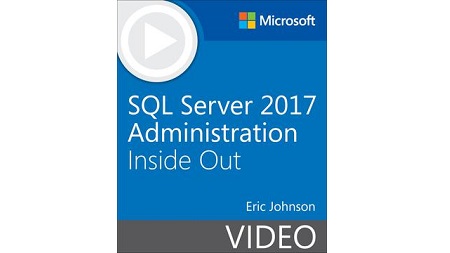
English | MP4 | AVC 1280×720 | AAC 44KHz 2ch | 9h 33m | 3.35 GB
A comprehensive guide to provisioning, managing, and securing SQL Server 2017 databases
In this video, database analyst and trainer Eric Johnson gives you the tools you need to manage SQL Server in your environment. You learn about the new features in SQL Server 2017, including running SQL Server on Linux. You also learn how to provision and secure Azure databases, design SQL Server tables, and tune and optimize SQL. The video wraps up by showing you how to manage data recovery and implement high-availability databases.
Throughout the video, Eric explains the concepts and methodologies of managing SQL Server databases and then puts techniques into practice with visual demonstrations. With Eric as your guide, follow his detailed steps and get hands-on practice to become a more experienced–and more efficient– database adminstrator.
Learn How To
- Install SQL Server administration and development tools
- Configure server memory and network settings
- Provision SQL Server databases, including Azure databases
- Manage user security and permissions
- Secure servers and data
- Design SQL Server tables
- Configure clustered and non-clustered indexes
- Create and verify backups and restore a database
- Implement high availability and disaster recovery
Table of Contents
01 SQL Server 2017 Administration Inside Out – Introduction
02 Learning objectives
03 1.1 Understand the Installation Center
04 1.2 Find the tools installed with the SQL Server
05 1.3 Use the performance and reliability monitoring tools
06 1.4 Understand SQL Server Management Studio
07 1.5 Understand SQL Server Data Tools
08 Learning objectives
09 2.1 Configure server memory
10 2.2 Setup database files
11 2.3 Configure network settings
12 2.4 Setup SQL Server security
13 Learning objectives
14 3.1 Install a new instance
15 3.2 Make post-installation server configuration changes
16 3.3 Install and configure database features
17 3.4 Create SQL Server databases
18 Learning objectives
19 4.1 Understand Microsoft Azure and database-as- a-service concepts
20 4.2 Provision a logical SQL Server
21 4.3 Provision a database
22 4.4 Setup security in Azure SQL databases
23 Learning objectives
24 5.1 Understand logins and users
25 5.2 Setup permissions in SQL Server
26 5.3 Migrate SQL Server logins
27 Learning objectives
28 6.1 Handle encryption in SQL Server
29 6.2 Setup row level security
30 6.3 Understand data masking
31 6.4 Configure SQL Server audits
32 Learning objectives
33 7.1 Review table design
34 7.2 Understand special table types
35 7.3 Create views
36 7.4 Use change tracking
37 7.5 Understand Change Data Capture
38 Learning objectives
39 8.1 Understand isolation levels
40 8.2 Use execution plans
41 8.3 Configure clustered indexes
42 8.4 Configure non-clustered indexes
43 8.5 Use index statistics
44 8.6 Understand parallelism
45 Learning objectives
46 9.1 Understand data recovery fundamentals
47 9.2 Understand backup devices
48 9.3 Understand different types of backups
49 9.4 Create and verify backups
50 9.5 Restore a database
51 9.6 Define a backup and recovery strategy
52 Learning objectives
53 10.1 Review high availability and disaster recovery technologies
54 10.2 Setup SQL Server log shipping
55 10.3 Use SQL replication for high availability
56 10.4 Read secondary database copies
57 Learning objectives
58 11.1 Monitor database backups
59 11.2 Deal with database corruption
60 11.3 Setup index maintenance
61 11.4 Configure statistics updates
62 11.5 Cleanup history
63 11.6 Shrink databases
64 11.7 Monitor database activity
65 11.8 Use performance monitor
66 11.9 Monitor database logs
67 11.10 Use resource governor
68 Learning objectives
69 12.1 Understand the components of SQL Server automated administration
70 12.2 Setup database maintenance plans
71 12.3 Configure multi-server administration
72 12.4 Use PowerShell to automate SQL Server administration
73 SQL Server 2017 Administration Inside Out – Summary
Resolve the captcha to access the links!